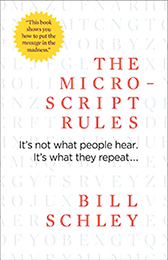Subscriber Benefit
As a subscriber you can listen to articles at work, in the car, or while you work out. Subscribe NowWhen I first saw the flyer for this book, I immediately thought of the potential for application to trial work. The book’s catch phrase “It’s not what people hear. It’s what they repeat,” has natural application for use with a jury, or so I thought. I believed that anything that can enhance a trial lawyer’s communication effectiveness is worth studying. Unfortunately, after reading this book, I was disappointed.
 The main point of this book is the author’s concept of the Dominant Selling Idea as it relates to marketing, selling, and politics. A DSI is a central proposition underlying the message much like a case theme. The concepts in the book are pretty much already obvious to the trial lawyer. The examples cited by the author are outdated and contrite. The author advocates making the DSI, or in trial parlance, case theme, simple and memorable like the oft-quoted phrase, “if the glove does not fit, you must acquit.” A DSI is generally a good idea to follow as it relates to developing a case theme. As the DSI model contemplates, it should sell your case in a simple short phrase. A DSI for a wrongful death of a child case might be: “For sale: Baby shoes. Never worn.”
The main point of this book is the author’s concept of the Dominant Selling Idea as it relates to marketing, selling, and politics. A DSI is a central proposition underlying the message much like a case theme. The concepts in the book are pretty much already obvious to the trial lawyer. The examples cited by the author are outdated and contrite. The author advocates making the DSI, or in trial parlance, case theme, simple and memorable like the oft-quoted phrase, “if the glove does not fit, you must acquit.” A DSI is generally a good idea to follow as it relates to developing a case theme. As the DSI model contemplates, it should sell your case in a simple short phrase. A DSI for a wrongful death of a child case might be: “For sale: Baby shoes. Never worn.”
The book introduces common terms like heuristics and metaphors. A heuristic is a mental shortcut that saves the brain from running thousands of algorithms leading to a quick conclusion. Think of it as a mental shortcut. Yes, juries use heuristics to help them analyze and decide a case and it is critical that trial lawyers identify naturally occurring case heuristics. That’s why focus groups are so critical. Once a heuristic is identified, it can be effectually incorporated into your trial strategy. The examples cited by the author are not really applicable for trial purposes.
Although the book is simple to read, in an hour or so, it offers little benefit to a seasoned trial attorney. Its nine chapters – 171 pages – are more aimed at a branding or a selling strategy: not as part of trial application. As a communication enhancing book it offers little insight from the lawyer’s perspective. In conclusion, perhaps I have unfairly compared this book to another book, “Winning with Stories” by Jim Perdue, which is a must-read for all trial lawyers.•
Rodney Nordstrom, Ph.D., J.D. is a trial consultant with his company Litigation Simulation Services located in Peoria, Illinois. The opinions expressed in this column are the author’s.
Please enable JavaScript to view this content.
